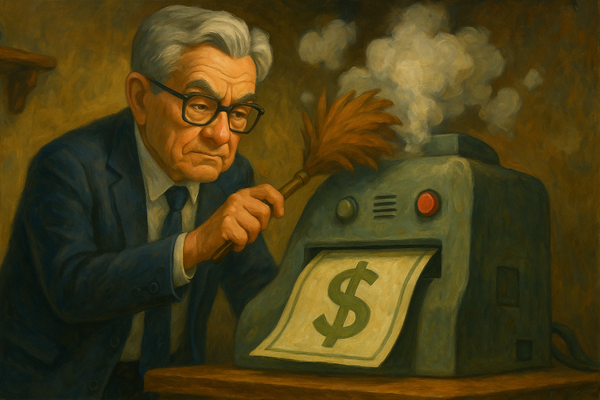Digital Resilience: Why Crypto Could Be Your Lifeline in a Tariff-Driven Economy

Over the past week, global markets have been rocked by one of the sharpest downturns in recent memory. Since April 2nd, when the U.S. government announced sweeping new tariffs on imports, U.S. equities have shed more than $6.8 trillion in value. The S&P 500 is down nearly 19% from its February peak. The Nasdaq 100 has entered bear market territory. The Dow Jones Industrial Average has dropped over 4,100 points across six trading days.
Bitcoin, while not immune, has shown notable resilience. After dipping from nearly $85,000 to $74,000, it has rebounded to around $78,000 — a rapid recovery compared to the broader market.
This isn’t just a moment of short-term volatility—it could be a signal of a deeper economic shift. And that’s where cryptocurrency, long touted as a digital alternative to traditional finance, may begin to show its real utility.
The Tariff Shock
On April 2nd, the U.S. administration implemented a 10% baseline tariff on all imports, with significantly higher rates for key trade partners: 104% on Chinese goods, 20% on EU products, 24% on Japanese imports, and 25% on South Korean exports.
China responded with 84% tariffs on all U.S. imports and placed several American firms on a restricted list. Other trade partners are considering similar countermeasures.
The result: a rapid and steep sell-off across global markets. As Bloomberg put it, “a trade war is no longer hypothetical—it’s here.” More than $6.8 trillion in value has vanished from U.S. equities alone, making this one of the largest and fastest drawdowns in recent history.
The Recession Question
With the markets in steep decline, recession concerns are mounting. Economists across the board are warning that prolonged tariffs could significantly slow growth.
UBS Global Wealth Management cautioned that if current policies persist, the U.S. economy is likely to tip into recession. Deutsche Bank estimates GDP could take a 1–1.5 percentage point hit this year, with a similar increase in core inflation. Nomura projects just 0.6% GDP growth for 2025 and sees inflation rising to 4.7%.
This isn’t about politics—it’s about numbers. And the numbers are pointing to a clear trend: the US and global economy is under pressure, traditional "safe" investments and the US Dollar aren't as bullet proof as people often think and the potential risk of a major economic downturn is gaining traction.
We’ll likely see continued volatility in traditional markets over the coming days, weeks, and possibly months as tariff negotiations unfold and policy shifts take shape. Any hint of a deal—or a rollback in current tariff rates—could trigger sudden spikes across equities. But the real question is whether those headline-driven rallies can sustain themselves. Until there’s more clarity and stability, short-term optimism may struggle to translate into long-term momentum.
Crypto’s Reaction: A Hint of Decoupling
At first, bitcoin didn’t budge. As U.S. stocks plunged midweek, bitcoin held steady—trading above $83,000 while the S&P and Nasdaq dropped sharply. It wasn’t until the weekend that crypto markets followed suit, with bitcoin dipping to around $74,000. But unlike equities, it rebounded quickly, stabilizing near $78,000 within days. That’s not just a bounce—it may be a sign of emerging independence.
Many crypto enthusiasts, including myself, have long argued that digital assets would eventually decouple from traditional markets. While full decoupling hasn’t happened yet, we’re seeing flashes of it. During key moments last week, bitcoin moved counter to equities—a small but very meaningful signal that shows its ability to chart its own path.
Each market cycle strengthens this divergence. Crypto still reacts to broad liquidity events, but with faster recoveries and, increasingly, its own market logic. That’s a sign of maturation—and of growing investor confidence in crypto as a legitimate asset class.
Crisis as a Catalyst
Rather than positioning crypto as a defensive hedge, a more accurate view might be to see it as a crisis accelerant—a sector that gains momentum when traditional systems show stress.
This has historical precedent. The 2008 financial crisis exposed flaws in the banking system, sparking Bitcoin’s creation. The COVID pandemic accelerated digital transformation across sectors. Now, the global trade war may be pushing another wave of innovation and adoption.
Here’s how economic turmoil tends to accelerate crypto adoption:
1. Trust erodes. Economic shocks reduce confidence in traditional institutions. That opens the door for alternatives—bitcoin, stablecoins, decentralized finance.
2. Monetary policy shifts. Central banks often respond to crises with rate cuts and stimulus, which can weaken fiat currencies and highlight the appeal of Bitcoin’s fixed supply.
3. Financial borders tighten. Tariffs, capital controls, and payment restrictions increase the appeal of borderless assets.
4. Innovation intensifies. Crises force real-world problem solving. The crypto projects that thrive now are the ones offering practical utility, not just hype.
So rather than serving as a bunker during the storm, crypto may represent the new growth that follows it.
Different Coins, Different Roles
Not all digital assets will respond the same way to macroeconomic pressure:
* Bitcoin continues to serve as a “digital gold” analog, with its capped supply making it attractive in inflationary environments. If the dollar’s global dominance is tested by ongoing trade friction, Bitcoin could benefit.
* Stablecoins may gain traction for everyday transactions, especially in countries where local currencies become unstable.
* DeFi protocols could see a rise in usage as people seek alternatives to traditional banks, especially if access to capital or cross-border transfers tightens.
Asymmetrical Risk and Recovery
One of crypto’s defining features is its asymmetrical risk-reward profile. While volatile, digital assets have historically recovered from downturns faster—and with higher upside—than most traditional investments.
After the 2008 crash, it took the S&P 500 five years to regain its previous high. During COVID, the recovery took months, BUT only after massive stimulus. Bitcoin and the broader crypto market, by contrast, have shown time and time again the unique ability to rebound sharply and hit new highs within compressed timeframes.
This volatility cuts both ways, but in recovery phases, it offers investors something rare: speed. For those with losses in traditional portfolios and limited time horizons, even a small crypto allocation can serve as a high-leverage recovery vehicle.
A Strategic Allocation, Not a Replacement
None of this means crypto should replace traditional investments. But the case for including it in a diversified portfolio—especially during macroeconomic stress—is stronger than ever.
Institutional investors have taken note. Many now recommend at least a 1–5% allocation to digital assets. The logic is simple: low correlation, high upside, and potential protection against fiat debasement or systemic risk.
As trade tensions rise and global economic uncertainty grows, crypto offers more than speculation—it offers diversification that traditional asset classes can’t match.
Conclusion: Clarity in the Chaos
Market disruptions often feel like endings. But more often, they mark transitions.
The 1970s energy crisis gave rise to globalization. The dot-com bust cleared the way for real internet innovation. The 2008 meltdown sparked the genesis of Bitcoin.
Today’s tariff-fueled turbulence may be doing the same—shifting attention toward decentralized, programmable, censorship-resistant financial tools. Tools that aren’t subject to the same fragility and politicization as legacy systems.
Crypto may not be the solution to every problem. But in a world of growing economic uncertainty, it represents something rare: an entirely different foundation.
Volatility will remain. Adoption won't be linear. But beneath the noise that often dominates the headlines, something foundational is shifting—and those who see it early will be positioned best.
WANT TO LEARN MORE? LET'S TALK!
I manage a private crypto fund that works with accredited and institutional investors. If you’re considering exposure for your portfolio, looking to learn more, or exploring strategic partnerships as an allocator or advisor, I'd love to connect!
🚀 Send me an email or a message on LinkedIn.
This article represents my personal views and not formal investment advice. All investments carry risk, and past performance is not indicative of future results. Please do your own research before making any investment decisions.




